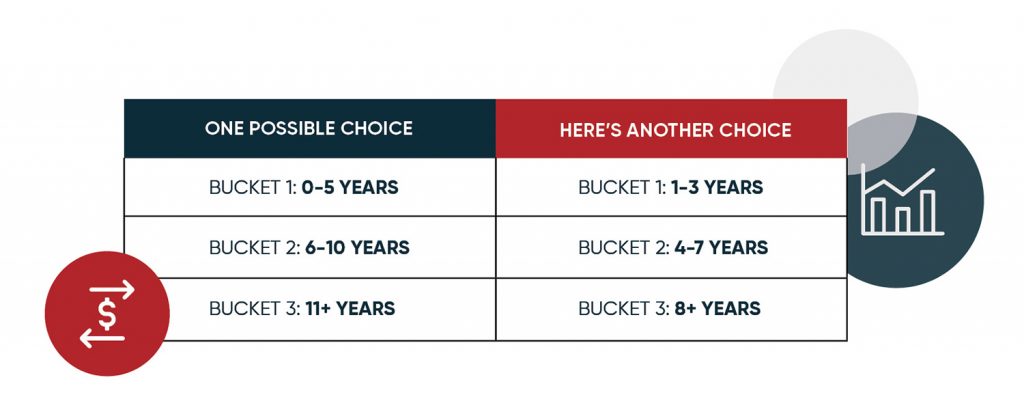What is the Retirement Bucket Strategy?
Key Takeaways
- Determine your buckets (s) by dividing your assets into buckets based on time horizons and risk levels.
- Each bucket serves a specific purpose and requires appropriate asset allocation. The short-term bucket focuses on liquidity and uses low-risk assets, the intermediate bucket balances stability and growth, and the long-term bucket aims for long-term growth potential with higher-risk investments.
- Implementing the retirement bucket strategy requires understanding the tax implications of different account types.
Most people want a stable retirement income. In a market environment, a solid plan is crucial. The retirement bucket strategy divides your savings into three buckets. Each suits different timeframes and risks, ensuring a steady income despite market changes.
Every financial plan has downsides, and the retirement bucket strategy is no exception. Before deciding whether it’s right for your retirement, it’s crucial to understand how it works. This article explores its purpose and potential benefits to help you determine if it suits your unique situation.
Determine your Bucket(s)
Though the number of buckets and timeframes varies, many retirees opt for three buckets. Here are a few common paths for retirement planning.

In Example 1, the buckets are organized as follows: Bucket 1 covers 0-5 years, Bucket 2 spans 6-10 years, and Bucket 3 is designated for 11+ years.
In Example 2, the buckets are structured as follows: Bucket 1 encompasses 1-3 years, Bucket 2 covers 4-7 years, and Bucket 3 is allocated for 8+ years.
Depending on your priorities and the length of your retirement, you can add more buckets or allocate a significant portion of your assets to the third bucket. Considering the increasing number of centenarians in the U.S. population, with more individuals enjoying extended retirement periods of 30 years or more, additional segmentation or more robust allocation to the long-term bucket may be desirable.
The bucket approach benefits individuals who must gradually liquidate their investments to cover living expenses. It allows you to categorize which assets you intend to liquidate during different periods without assuming that a single asset allocation plan will suffice for all your buckets. This approach provides flexibility and customization to accommodate your evolving needs throughout retirement.
Bucket 1 Short Term (0-5)

This “cash bucket” covers two years of retirement income, including Social Security, pensions, annuities, and life insurance.
Low-risk fixed-income assets are used, prioritizing reliability over high returns. The following income sources are examples that may fall within this category:
- Savings Accounts or Cash Equivalents
- Certificates of Deposit (CDs)
- Short-term Bonds
- Money Market Accounts
- Annuities
The short-term bucket aims for liquidity, ensuring you can cover expenses without worrying about market changes. As it depletes, the strategy involves replenishing it with returns from your other two buckets.
Bucket 2 Intermediate (6-10)
The intermediate bucket focuses on income needs three to seven years later. It serves a dual purpose: generating income while maintaining stability. With a medium risk tolerance, its primary goal is liquidity, ensuring you can meet income needs without excessive concern about market changes. Striking the right balance is crucial to avoid losses, which can hinder your ability to meet those needs.
For the desired outcomes, the intermediate bucket uses various assets, such as:
- Longer-term Bonds
- Real Estate Investment Trusts
- Annuities
- Structured Notes
- Value and Growth Stocks – These Exchange-Traded Funds (ETFs) or mutual funds are designed to provide stability or growth. They may generate dividends that can be distributed or reinvested into the security.
Returns from this long-term growth bucket can be used to replenish your short-term bucket as needed, ensuring a continuous flow of income. By carefully managing and allocating assets within the Intermediate Bucket, you can maintain stability while preparing for future financial needs.
Bucket 3 Long-Term (11+)

The long-term bucket is specifically designed for long-term growth potential. This bucket is dedicated to higher-risk investments that aim to outpace inflation over the long term. While these investments may exhibit volatility and short-term value fluctuations, the goal is to achieve substantial returns over the next decade and beyond. Assets commonly found within this bucket include:
- Growth Stocks
- Real Estate or REITs
- Alternative Stock Market Strategies
- Hedge Funds & Other Investments
Retirees can generate income from these investments by allocating assets to the long-term bucket and replenishing their intermediate bucket. This strategic approach ensures that growth-oriented investments meet future income needs and retirement spending while maintaining a long-term perspective.
Taxes and the Retirement Bucket Strategy

Intricacies of Taxes within the Bucket Strategy
When implementing the Bucket Strategy, understanding tax implications is crucial. Taxation depends on the account types from which you withdraw funds. Let’s explore the tax considerations associated with various account types:
-
401(k)s and traditional IRAs
Withdrawals from these accounts are subject to ordinary income tax rates. As you tap into these tax-deferred retirement accounts, the amount withdrawn will be included in your taxable income for the year. It’s essential to consider your tax bracket and plan withdrawals accordingly to optimize tax efficiency.
-
Brokerage Accounts and MMA
These accounts are not subject to tax when funds are withdrawn. However, it’s important to note that the earnings generated within these accounts, such as capital gains, interest, and stock dividends, may be subject to taxation. The specific tax treatment of these earnings depends on factors like the duration of your investment or mutual fund and your overall tax situation.
Understanding the tax implications of each account type helps you strategically allocate assets within the Bucket Strategy, minimizing tax burdens and optimizing your overall financial plan.
Benefits of the Retirement Bucket Strategy
The bucket strategy emerges as a beacon of financial wisdom. Let’s examine its remarkable benefits.
Shielding Against Market Volatility
Retirement shouldn’t be a roller coaster ride for your finances. The bucket strategy is a robust shield, safeguarding retirees against unpredictable market ups and downs. By strategically dividing your assets into buckets based on time horizons and risk levels, this approach ensures that your income needs are met, irrespective of market volatility. Say goodbye to the sleepless nights caused by market fluctuations and embrace the peace of mind that comes with a well-structured strategy.
Unlocking Growth Potential
While stability is crucial, growth cannot be ignored. The bucket strategy perfectly balances capital preservation and growth potential. By allocating assets to the appropriate buckets, retirees can enjoy the long-term benefits of higher-risk investments. The growth-oriented Long-Term Bucket is earmarked explicitly for assets with substantial growth potential, such as individual stocks, real estate, or venture capital investments. This strategy allows retirees to harness the power of compounding returns, potentially beating inflation and securing their financial future.
Streamlined Portfolio Organization
A well-organized portfolio is the foundation of any successful retirement plan. The bucket strategy brings clarity and structure to your investments, allowing for efficient management and decision-making. By categorizing assets into buckets based on time horizons and risk profiles, you gain a comprehensive view of your financial landscape. This streamlined approach simplifies your asset allocation process and empowers you to make informed decisions about rebalancing and replenishing buckets as needed. Enjoy the peace of mind that comes with a neatly organized portfolio.
Drawbacks of the Retirement Bucket Strategy

Though the bucket strategy is a clear retirement income plan, it’s crucial to examine potential drawbacks that may make it unsuitable for your unique financial situation. Let’s explore these considerations:
Asset Sufficiency
The effectiveness of the bucket strategy hinges on allocating a sufficient nest egg across the different buckets. To meet your income needs and ensure the longevity of your retirement, you must possess a vast pool of assets. If your retirement savings fall short, implementing the bucket strategy may prove challenging or require adjustments to align with your available resources.
Alignment with Investment Style
Every investor has a distinct investment style, and the retirement bucket strategy may need to align with your approach. This strategy emphasizes diversification across buckets based on time horizons and risk levels. However, if you prefer a different investment strategy, such as a concentrated portfolio or an active trading approach, the bucket strategy may not fully align with your investment style. Evaluating how well the plan aligns with your preferences is essential before fully embracing its implementation.
Balancing Act
The approach requires ongoing maintenance and balance. As time passes, you’ll need to assess and adjust the allocation of assets across buckets continuously. Rebalancing becomes necessary to ensure each bucket remains adequately funded and aligned with your changing income needs. This ongoing management can require time, effort, and monitoring, which may not suit investors seeking a more hands-off approach.
Though the retirement bucket strategy offers many benefits, it’s essential to recognize potential drawbacks. Assess asset sufficiency, evaluate alignment with your investment style, and be prepared for necessary balance adjustments to determine its suitability for your retirement plan.
Consulting with a qualified financial advisor can provide valuable insights tailored to your circumstances. By carefully using financial advisors and weighing the benefits and drawbacks, you can make informed decisions to shape a retirement strategy that aligns with your goals and aspirations.
A Sequence of Returns Risk

We often focus on risks such as market volatility or interest rate fluctuations in retirement strategies. However, another risk can significantly affect your retirement savings: the sequence-of-returns risk. This risk refers to the order in which you experience investment returns and how it can affect the longevity of your retirement funds.
In a well-diversified retirement portfolio, some assets provide growth while others generate income. The ideal scenario is that the growth portion of your investment portfolio keeps pace with your withdrawals, replenishing the funds as needed. You may encounter a prolonged downturn in investment growth during the early retirement years. In that case, it can substantially impact your overall portfolio value and its ability to sustain your income needs.
Imagine a scenario where you start taking annual withdrawals during a market downturn, often called the “fragile decade” of retirement. Lower asset values may force you to sell more investments to meet your income needs. Selling assets, in turn, reduces the number of assets available to generate returns in the future, further compounding the impact on your portfolio’s value and its capacity to sustain withdrawals over time.
The sequence-of-returns risk becomes particularly concerning for retirees, as they have limited time to recover from losses while simultaneously withdrawing income. To mitigate the sequence of returns risk, consider the following investment strategies:
-
Diversified Portfolio
By diversifying your investments across different asset classes, you can minimize the effects of market volatility on your portfolio. Avoid relying too heavily on the stock market and gradually reduce your stock exposure as you approach retirement.
-
Implement a Phased Retirement Approach
Gradually adjust your investments over time, reducing the percentage of stocks in your portfolio as you retire. This approach helps protect you from the impact of sequence risk by gradually shifting your investments to more conservative options.
-
Utilize a Retirement Bucket Strategy
Adopting a bucket strategy can be an effective way to manage the sequence-of-returns risk. This strategy involves dividing your portfolio into distinct investment buckets, each serving a specific purpose and generating additional returns. Categorize income needs into short-term, mid-term, and long-term buckets to ensure meeting needs without selling investments at unfavorable times.
-
Work with a Financial Advisor
Partnering with a knowledgeable financial advisor or certified financial planner can provide valuable guidance in setting up your retirement buckets while managing sequence-of-returns risk. They can help you develop a comprehensive retirement plan, optimize your withdrawal strategy, and align your investment objectives with your long-term goals.
Get started with a complimentary, no-obligation consultation.

